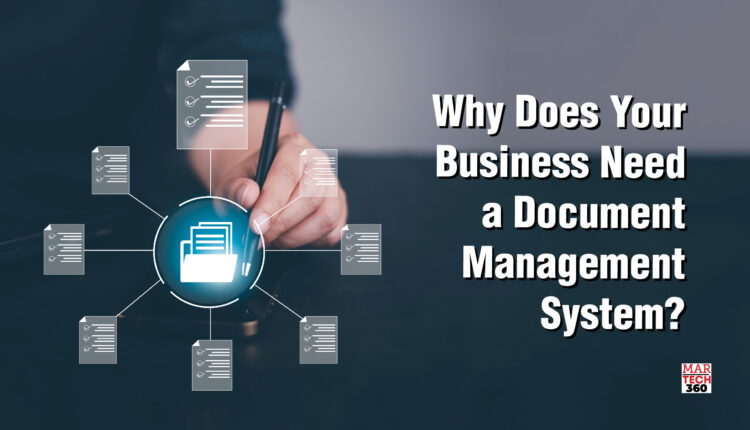If you are a business owner, chances are you have a ton of crucial documents stored in your system. Imagine if you have no idea where they are stored, or even worse, if they are stored in the first place. It would be chaotic, wouldn’t it? This is exactly where document management systems come into play.
The use of a computer system and software to store, manage, and track electronic documents and electronic images of paper-based information obtained through the use of a document scanner is known as document management, also referred to as document management systems (DMS).
It is an intricate process through which you store, control, and keep track of electronic documents. Without adieu, let’s dive deeper into document management systems, shall we?
What is a Document Management System?
The use, management, and archiving of papers within a company is known as document management. These papers could be in a variety of formats, including PDFs, photos, videos, audio, spreadsheets, code packages, and more.
While some enterprise document management systems maintain physical materials or both, the majority of them concentrate on digital content. Systems for managing documents act as a central repository for all data and records in your business. Anyone with access knows where to search when they need something.
The process of managing the document life cycle is greatly simplified by the use of document management software. To manage, update, and preserve shared and utilized company documents, you can set up automated workflows and processes.
Proper maintenance of legal document management systems benefits from the following:
- Integrity with groups, clients, and partners
- Efficacy of processes and systems
- Adherence to regulatory requirements and industry norms
As defined in ISO 12651-2, a document is “recorded information or object which can be treated as a unit.” Although it can seem a little challenging at first, you have been using this method to create, share, and use it for years.
Today, businesses employ several types of document management systems for different purposes, some of them are:
- Content Management Systems
- Workflow Management Systems
- Records Management Systems
- Document Imaging Systems
- Enterprise Content Management Systems (ECMs)
Why Do Companies Need Document Management System Software?
 Amidst the ongoing influence of COVID-19 and the transition to hybrid or remote work models, forward-thinking business owners and managers have moved beyond relying on ad-hoc systems to manage, store, and share documents. In the current dynamic business landscape, the need for more sophisticated and efficient document management solutions has become evident.
Amidst the ongoing influence of COVID-19 and the transition to hybrid or remote work models, forward-thinking business owners and managers have moved beyond relying on ad-hoc systems to manage, store, and share documents. In the current dynamic business landscape, the need for more sophisticated and efficient document management solutions has become evident.
Companies use document management systems to get insight into and control documents and data coming into and going out of the organization. You want to make sure that all employees, whether they are based in the office or working remotely, use the most recent and updated copies of the papers.
The document management system software makes it simple for team members to offer comments, recommendations, and annotations, facilitating collaboration, communication, work review, and approval.
By generating audit trails of a document’s life cycle from creation to modification and distribution, document management system software also addresses security and data audit challenges. This can serve as a reminder of internal responsibility or as a trigger for an industry authority’s external audit.
What Are the Benefits of Document Management Systems?
 The advantages of using document management systems are substantial and multiplying quickly. The market for these systems is estimated to be worth more than $6.5 billion.
The advantages of using document management systems are substantial and multiplying quickly. The market for these systems is estimated to be worth more than $6.5 billion.
Having a document management system has numerous pivotal advantages, including:
- Better teamwork: Collaboration is improved since team members always have access to the most recent version of any document.
- Enhanced security: Document management solutions make sure that all papers received and sent by your organization are safe and kept securely on a central platform that is available to all teams.
- Document tracking: These systems assist in tracking a document’s history, right from creation to edits and downloads, for compliance and audits. For business audits and industry compliance procedures, this information is essential.
- Information accessibility: Strong search capabilities are typically found in document management systems, making it simple for teams to locate the necessary documents when they are needed.
- Increased productivity: By using a document management system, employees can avoid wasting time searching through different PCs, apps, or cloud-based platforms for certain files. Anyone with access can use the search box to quickly find the papers they require.
Some of the best document management systems available include DocuWare, M-Files, and Templafy.
What’s on the Horizon for Document Management Systems
DMS will likely experience significant developments in the future, ushering in a new era of productivity and security. Utilizing AI-driven insights to foresee user demands and offer pertinent documents in real time through predictive analytics and Personalized Document Recommendations (A) will transform how enterprises handle massive amounts of data. This proactive strategy will speed up information retrieval and boost output.
The use of augmented reality (AR) for interactive document collaboration has the potential to completely change how teams work together on documents. AR enables real-time annotations, virtual meetings, and interactive discussions by superimposing digital material onto the real world. This promotes fluid cooperation over geographical distances.
Additionally, Enhanced Data Security and Quantum Computing represent breakthroughs in data security. Stronger encryption will be possible because of quantum computing’s unmatched processing capacity, rendering documents nearly impermeable to online attackers and protecting sensitive data.
These developments, which are expected to influence DMS going forward, present intriguing opportunities for companies looking to improve overall efficiency in a rapidly evolving digital environment while streamlining document workflows and ensuring data integrity.
How is DMS Used in Various Industries?
Organizations from a range of industries consider DMS systems appealing due to their adaptability, including but not limited to the following.
- Healthcare: DMS solutions help ensure regulatory compliance, enhance patient care, and enable the secure storage and sharing of sensitive medical records.
- Legal: DMS systems are used by law firms and legal departments to manage heaps of case documentation, contracts, and correspondence, along with streamlining workflows and enhancing collaboration.
- Financial Services: Financial organizations use DMS platforms to store and manage transaction records, account statements, and other crucial financial documents, thereby assisting in compliance with changing regulatory requirements.
- Manufacturing: DMS systems are used by manufacturers to maintain documentation for product specifications, quality assurance, and safety rules, promoting a culture of continuous improvement.
Final Thoughts
Modern businesses today place a greater emphasis on document management systems due to their many advantages, including higher document storage capacity, simple document retrieval, and increased data and knowledge security. An organization’s entire structure can be affected by implementing a well-thought-out document management system, which also makes document storage, retrieval, and sharing easier. In conclusion, document management is a crucial tool for every business, and an effective system may greatly increase record-keeping effectiveness and promote business expansion.


Comments are closed.